 |
| Image via Simply Gemstones |
 |
| Kashmir Sapphires Image via Palagems |
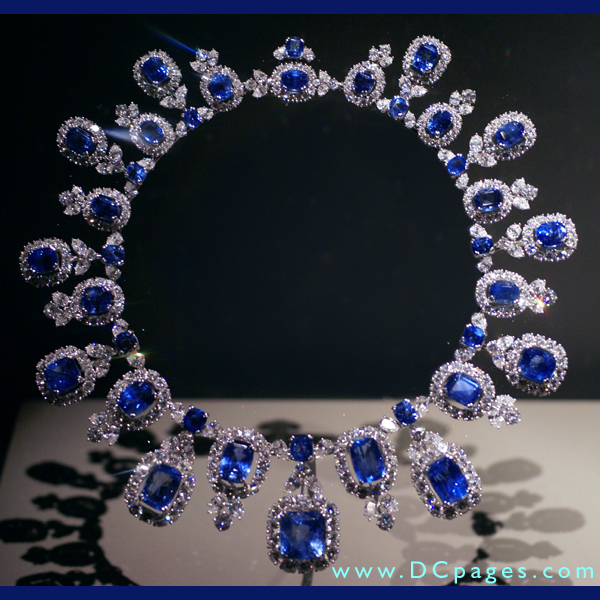 |
| The Hall Necklace- 195 carats of sapphire Currently at Janet Annenberg Hooker Hall of Geology, Gems, and Minerals at the Smithsonian Image via DCPages |
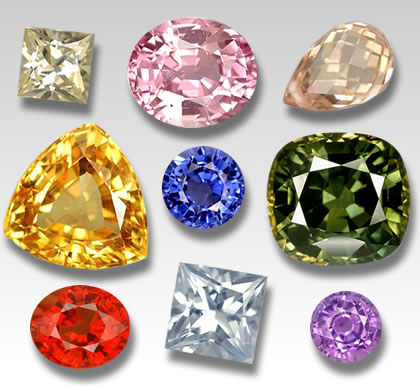 |
| Image via GemSelect |
Hey, wait a minute! What are those fancy colored stones doing in September's Sapphire post?
Well, it turns out that sapphires are composed of the aluminum oxide mineral corundum which comes in a variety of colors depending on trace amounts of other elements such as iron, titanium, or chromium. But be careful now because corundum heavy on the chromium is actually--- wait for it ---- a ruby. So- sapphires can be almost any color, depending up the traces of other elements, unless they are red. Red sapphires are not sapphires, they are rubies. And then there is my very favorite gemstone (so far!) the Padparadscha sapphire, the drop dead gorgeous pink-orange gem in the upper right corner of the photo above.
So now you may be asking yourself if September's birthstone must be blue? In short- no, it doesn't. But blue has been the most popular color for sapphire. It is also the most common color of sapphire, which is why sapphires, no matter their color, are called sapphires, from the Latin "sapphirus" for blue though a few other sources attribute the name to the Persian word "safir", meaning "beloved of Saturn" Blue sapphires get their color from iron and particularly titanium. Sapphires in other colors are identified by that color: pink sapphire, yellow sapphire, etc. Except red sapphire because that's a ruby. Are y'all trying as hard as I am not to be confused?
Well, it turns out that sapphires are composed of the aluminum oxide mineral corundum which comes in a variety of colors depending on trace amounts of other elements such as iron, titanium, or chromium. But be careful now because corundum heavy on the chromium is actually--- wait for it ---- a ruby. So- sapphires can be almost any color, depending up the traces of other elements, unless they are red. Red sapphires are not sapphires, they are rubies. And then there is my very favorite gemstone (so far!) the Padparadscha sapphire, the drop dead gorgeous pink-orange gem in the upper right corner of the photo above.
So now you may be asking yourself if September's birthstone must be blue? In short- no, it doesn't. But blue has been the most popular color for sapphire. It is also the most common color of sapphire, which is why sapphires, no matter their color, are called sapphires, from the Latin "sapphirus" for blue though a few other sources attribute the name to the Persian word "safir", meaning "beloved of Saturn" Blue sapphires get their color from iron and particularly titanium. Sapphires in other colors are identified by that color: pink sapphire, yellow sapphire, etc. Except red sapphire because that's a ruby. Are y'all trying as hard as I am not to be confused?
 |
| Image via Molecular Expressions |
Sapphires are formed when corundum crystals are exposed to high heat and pressure. They form in various igneous (cooled magma) or metamorphic (rock subjected to heat or pressure to such an extent that it changes form) rocks.
 |
| Corundum |
 |
| Sapphire bearing corundum Both images via ehow |
Corundum has a hexagonal structure and is second only to diamonds in strength. Because of this strength, corundum does not easily wear or erode and is often found in alluvial deposits. This means the stones, having been formed deep below the earth's crust and brought to the surface by volcanic activity, wash out in streams and other waterways, some that no longer exist. These stones are sometimes "cemented" to the existing matrix but mining this type of sapphire is difficult. Because of sapphire's specific gravity (measurement of density compared to that of water), they do not generally travel too far from their source in an alluvial deposit.
| Worlds' largest star sapphire, the 536 carat Star of India. About the size of a golf ball. Image via Weldon |
Sometimes corundum will form with needle-like inclusions of Rutile. When these needle-shaped inclusions reflect light in the shape of a star, which appears to travel over the surface of the stone when cut. This is called asterism.
So where do we find sapphires? All over! Top producers of this gemstone include such places as Brazil, Tanzania, Sri Lanka, Kashmir, Thailand, Madagascar and Australia. Even good ol' Montana gets in on the act.
 |
| Image via The Natural Sapphire Company |
For centuries, Sri Lanka has been the primary source for fine gem quality sapphires though Madagascar became the world leader in production as of 2007. Sri Lanka, where mining has occurred for over 2,000 years, maintains strict regulatory controls over how and where mining may take place in order to prevent destruction of the land. Sri Lanka also monitors their workers to ensure that they receive fair treatment.
Myanmar (Burma), which produces some of the world's most beautiful rubies, also produces very fine sapphires. These stones tend to be very deep blue in color. As we learned with Rubies, many countries have called for a ban on trade in Burmese gems due to human rights abuses such as forced labor and child labor in Myanmar.
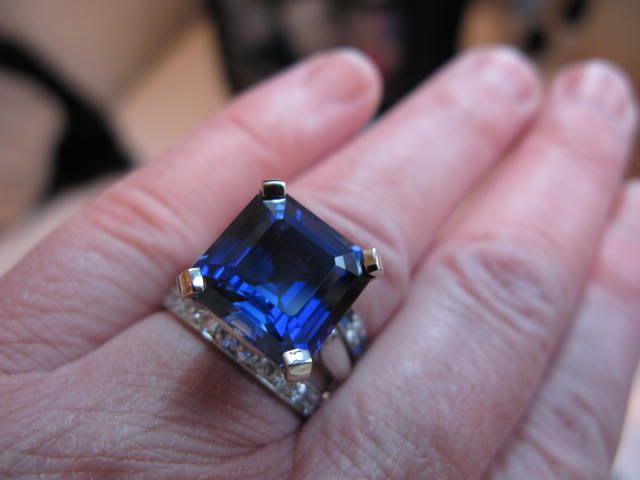 |
| 12mm Kashmir Diamond Ring Image via Better Than Diamonds |
Then there are the Kashmir sapphires. Let me quote from The Natural Sapphire Company:
Kashmir sapphires were found in a very remote mountainous region of India in the late 1800’s. The stones were in most cases exceptionally fine quality. The color tone term “cornflower blue” was coined from these stones. The term is generally described as “velvety” or “sleepy” being that the color is very soothing and appealing. The deposit was exhausted by the 1920’s and there have been no new finds in the Kashmir area.
For this reason the prices for Kashmir sapphires have been wildly valued. Prices can be 10 times the cost of a comparable blue sapphire from another country.
Blue Sapphires, because they are more rare than diamonds, have long been given for engagements by royalty. Princess Diana's diamond encircled engagement ring, now firmly entrenched on Kate's finger, is perhaps the most famous royal sapphire engagement ring in recent years. Large sapphires are rare and often attract fame and myth. The largest star sapphire is the Star of India at an amazing 536 carats. Discovered about three hundred years ago in Sri Lanka, the Star of India was donated to the American Museum of Natural History by the financier J.P. Morgan. Later the infamous burglar Jack Murphy, Murph the Surf, stole the stone. Its recovery two months later only added to its fame.
And the lore, ah the lore. Ancient Persians believed the entire Earth was held in place inside a massive sapphire stone and that the blue sky was a reflection of sapphires. Buddhist culture believes that sapphires lead to prayer and in many religions sapphires represent the heavens and holiness. In the Middle Ages, sapphires were believed to ward off many diseases and ailments, and were seen as a symbol of purity.
 |
| 21.55 carat rough cut brown sapphire Image via IOffer |
If you are a September baby, specifically a Taurus (though I strictly do not follow astrology) and you wear a sapphire, it is believed by some that you will not only be protected from but also cured from mental disorders. For the rest of us, sapphires are said to protect the innocent, bestow truth, promote good health, and preserve chastity.
Ancient Persians ground sapphire for use as an all purpose medicine and in the Orient, Saturdays were the day to wear blue, including blue sapphires which were believed to promote wisdom. Blue sapphire was also believed to promote sincerity and faithfulness as the stone would dim if one's spouse had been untrue. Tradition holds that God gave the Ten Commandments to Moses on tablets of sapphire. Blue sapphires were also believed to have gender, darker stones being female, the lighter stones being male. They were also believed to relieve mental tension and dispel depression.
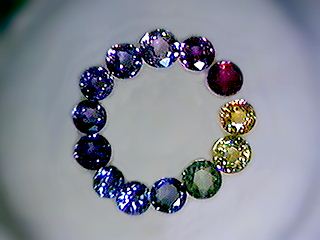 |
| Image via The Image |
Pink sapphire is believed by some to enhance romance and relationships. Yellow sapphire supposedly enhances money-making schemes and gives leaders the ability to make right and wrong decisions. Oh? Let's pass some of those out! Yellow was also the color to stimulate intellect and remove toxins from the body. Green has been purported to stimulate the heart and therefore one’s capacity for compassion, loyalty, and trust in others. They also enhance your ability to recall dreams. Purple sapphires improve meditation and are said to be effective in calming overwrought emotions while black sapphires help to build your career and improve your powers of intuition.
 |
| World's largest carved sapphire. Twenty-eight pounds, about the size of an American football. Image via Jewellry Monthly |
When you're ready to go shopping, look for sapphires that are what's called "eye-clear" meaning no visible occlusions. Always ask to look at a stone of interest under a microscope and avoid those with deep occlusions that may reach the surface. Stones with these deep occlusions could shatter with hard impact. Sapphires are readily available up to 1 carat, larger stones being more expensive due to their rarity. Do not buy stones labeled "Specimen Grade" as these stones are of poor quality and have little value. Ask about any treatments to the stone. Most sapphires are heat treated to enhance color and clarity. The Natural Sapphire Company has extensive information on common treatment methods as well as some interesting before and after photos. Actually, if there is anything at all you want to know about sapphires, go to The Natural Sapphire Company. They even have a place to make your Wish List! Natural, untreated stones are more valuable but also most costly as they are not readily available. This will generally mean that you do not want to purchase your sapphire at the counter of a department store as they generally do not have information specific to the stones you are considering. Oh! Did you notice I used the plural? Stones, not stone. Just a little slip there. Star sapphires should have a well-defined star and are generally cut in a dome shape (cabochon). The round or brilliant cut stone is usually more expensive than other cuts such as the pear or oval. As with the ruby, color is an important factor in determining value- avoid stones at either end of the saturation spectrum. Think of Goldilocks: Not too dark, not too light- just right. Synthetic sapphires have been available since 1902. If a sapphire is labeled "created" or "cultured" it is not natural. Look for sparkle and fire. If it looks like glass it either is glass or not worth paying for.
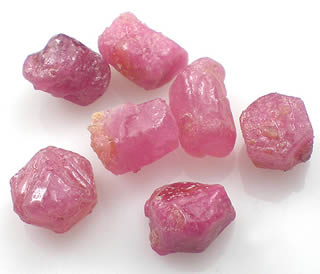 |
| Pink sapphire. Image via Gem Select |
So once you have your sapphires safely within your possession take good care of them. Because sapphires are so hard, they are generally very durable. Common sense tells us to avoid extremes of heat or cold as well as sudden impact. The old saying for jewelry in general goes "Put them on last, take them off first." Finish all of your primping, powdering, gelling, shellacking, and spraying before you don your gems. Best to take them off for household cleaning chores and things like swimming. Better safe than sorry. You can clean sapphires with warm water and mild dish liquid, using a soft tooth brush if needed. Ultrasonic cleaners can also be used. As with diamonds and rubies, store your sapphires in a separate soft cloth bag or in a separate compartment of a jewelry box. Because they are so hard, sapphires could easily scratch other jewelry.
Ready for a tour? Let's go...
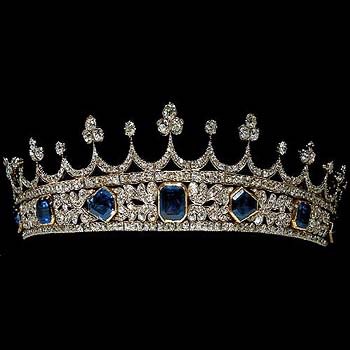 |
| Queen Victoria's Tiara, circa 1842 Image via The Dreamstress |
 |
| Carved sapphire bat brooch. Sold at auction for $2,700 Image via Skinner Auctioneer & Appraisers |
 |
| Natural (unheated) sapphire and diamond necklace. Victorian. Image via Duke's Auctions |
| 12-Ray purple star sapphire Image via Gemology Online |
| Color Change sapphire. Left- Incandescent light, Right- Fluorescent Light Image via Professional Jeweler |
| Antique sapphire and diamond tiara. $100,440 at auction. Oops- another tiara? I see a tiara only post in the future. Image via Christie's |
 |
| 2 carat sapphire Edwardian Ring, circa 1910. Image via Antiques Hot Spot |
And just when I was beginning to think there were no sapphire butterflies, these lovelies came flittering in.
 |
| Image via Aspire Auctions |
This one has only a smattering of sapphires but was way to gorgeous to leave out.
 |
| Enamel butterfly brooch with cab sapphire and old cut diamonds. Image via Morelle Davidson Jewellry Call for price. And if you have to ask, you can't afford it. |
 |
| Multi-color sapphire and diamond ring. Image via American Ring Store |
 |
| Image via Perfect Jewels |
OK- that's it. I can't take any more- too gorgeous. Bling overload!
 |
| Image via jzlikesab |
Happy Birthday (some belated I'm sure- my apologies) to all of my September Butterflies. Like sapphires, you're each multi-colored and very precious.
And thank you all for visiting today. I appreaciate it.
See ya next time!
NOTE, 9/18/2011- After posting, I received an email from Anonymous with the following link regarding the Natural Sapphire Company, which is quoted in this post:
My Sapphire post went up on the12th. The above referenced post on The Natural Sapphire Company blog (find it under the "Company" tag) also went up on the 12th. Anonymous emailed me on the 13th. Pretty on top of things. The rebuttal post linked above is not dated as far as I can find and who actually wrote the rebuttal is not directly identified either. Not even when you send them an email via the "Contact US" tab on the page, which I did not do because, you know, who are they? Every other link on the other pages that I clicked on took me to Wild Fish Gems. I'm just sayin' what happened.
Anonymous wants us to be aware that there are some shenanigans going on over at the The Natural Sapphire Company. Apparently there have been complaints about credit card security, properly filling orders, stone substitution, doctoring photos, etc. I have been trying to figure it all out with some Internet research and, as with most things that hit the legal system, it's hard to do. Quite frankly, I do not have the time or interest in sorting out the legal troubles of the NSC. So let me say the following:
- I have not done business with The Natural Sapphire Company and do not know anyone there. For that reason, I did not recommend doing business with the NSC in this post.
- Business practices aside, the information about sapphires from the NSC appears to be legit. Since I am not a gemologist, I generally try to double check information so that it is correct for you. I stated that you should check out the NSC if there's anything you want to know about sapphires. That is not a recommendation to do business. Please let me know if you can verify information about sapphires quoted here from the NSC as not true.
- I am not defending the NSC. Illegal activity by anyone should, by all means, receive it's just rewards. Anyone who purchases costly items (or any item) over the Internet is kind of taking a risk. We should all know that by now and I do hope that you are being cautious. I would want to see my bling in person before buying, instead of trusting a photo, so sending off several thousand dollars over the Internet would never be an issue. As if... I am, quite frankly, just a bit put out with Anonymous, whose email may or may not have been part of the smearing going on between the two parties- I don't know and have no way of finding out. That's the problem with signing things anonymously. I say "put out" the way a child who is having a good time playing would when reminded by a parent that bedtime is coming, that caution needs to be taken, that chores are awaiting, or sugar is not good for us. "Awwww Mom, we were just looking at the bling." If legit, I truly do appreciate Anonymous's desire to caution us, otherwise it's kind of a buzz kill.
So have a good time looking at the pretty sparkly things but do keep an eye on your wallet.


Beautiful and well researched as always. Personally I love the pink sapphire, I don't understand how only the blues get the upper hand.
ReplyDeletehttp://polwig.com
Wow! That first image was blindingly beautiful! Grabbed my eyes and wouldn't let go!
ReplyDeleteDiamonds truly are a dime a dozen when compared to much more rare stones like Sapphires and Rubies and Emeralds so i can understand that royalty chooses Sapphires as engagement rings.
Thank you again for this beautiful post and for all the time and work and effort and research that went into making it.
Kathy- I agree, the pink sapphires are my favorite as well. But I wouldn't turn down a blue one, mind you. Thanks for your comments.
ReplyDeletePam- I like to try to use a photo at the top that grabs you by the collar and says "Hey, look how gorgeous I am!" Thanks so much for your comments.